Best Bed for Autistic Child
When my friend's son, who has autism, struggled with sleep disturbances and sensory sensitivities, finding the right bed became a pivotal task.
After extensive research and consultations with experts, one particular bed stood out for its innovative design tailored to meet the unique needs of autistic children.
The impact of a suitable bed on a child's overall well-being can be transformative, but the journey to discover the ideal bed involves maneuvering through a myriad of considerations beyond the surface level.
Key Takeaways
- Prioritize safety features like sturdy frames and railings for peace of mind.
- Ensure the bed meets sensory needs with sensory-friendly fabric choices.
- Opt for a medium-firm mattress to provide comfort and support.
- Regularly maintain the bed to uphold safety standards and cleanliness.
Factors to Consider
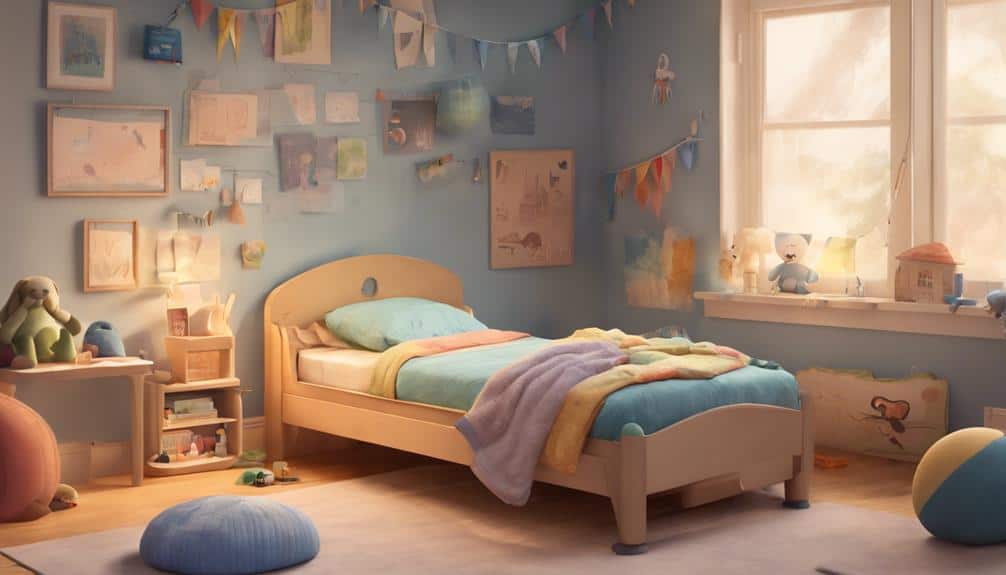
Considering your child's sensory needs and preferences is key when selecting the best bed for an autistic child. Special needs beds like the Safety Sleeper can provide a secure and comforting environment for your child. These beds often come with safety features such as sturdy frames and secure railings, ensuring that your child is safe during the night.
When choosing a bed, it's vital to look for one that meets your child's specific requirements. For example, a low-profile bed may be suitable for a child who's sensitive to heights, while a tent bed can offer a cozy and enclosed space for those who seek extra comfort. The size of the bed is also important; it should allow for comfortable movement and fit well within your child's room without feeling cramped.
Before making a decision, seeking feedback from healthcare professionals or other parents of autistic children can provide valuable insights and recommendations on the best bed choice for your child's unique needs.
Safety and Security
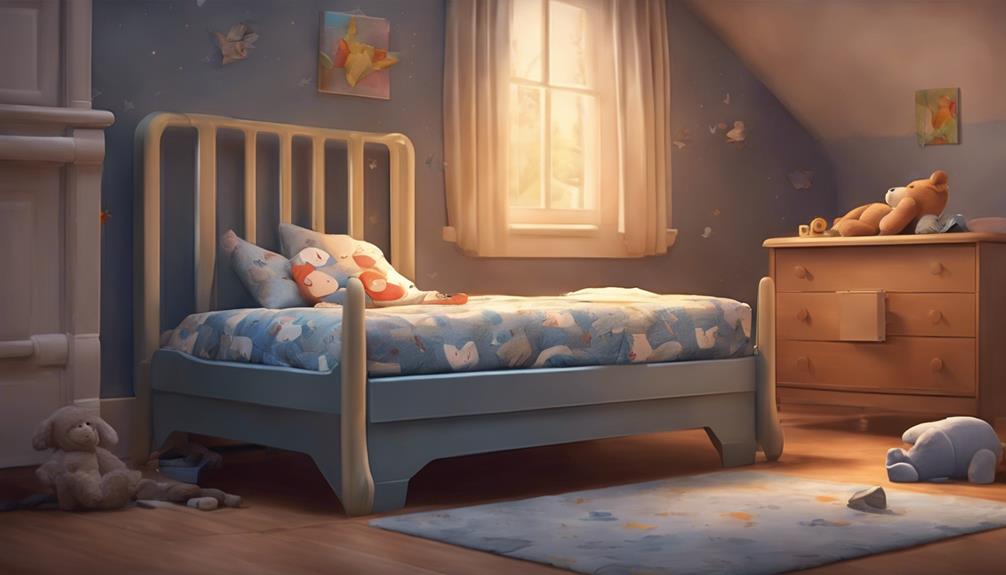
When considering the best bed for an autistic child, safety and security are paramount concerns. Bed rails can provide a sense of security and prevent falls during sleep, while cozy enclosed spaces can offer comfort and a feeling of protection.
It's important to prioritize these features to guarantee a safe and secure sleeping environment for children with autism.
Bed Rails for Safety
Bed rails serve as an essential safety feature for autistic children during sleep, creating a safe place and preventing falls. These rails act as a protective barrier, offering security and peace of mind to caregivers. For children prone to moving around or rolling out of bed, bed rails are highly recommended. By providing a physical boundary, they reduce the risk of accidents during the night.
Caregivers can rest assured knowing that their child is protected and secure while sleeping. Bed rails come in various sizes and styles to suit different bed types and preferences, ensuring that every child can have a safe and comfortable sleeping environment.
Cozy Enclosed Spaces
For autistic children, creating a cozy enclosed space for sleep is important to providing a sense of safety and security. Enclosed spaces offer a controlled environment that can reduce anxiety and sensory overload, promoting better rest.
When looking for the best bed for an autistic child, consider options like tent beds or cubby beds that provide a snug and calming space for improved sleep quality. These cozy enclosed spaces help prevent wandering and establish a comfortable sleeping environment, vital for children with autism.
Comfort and Support
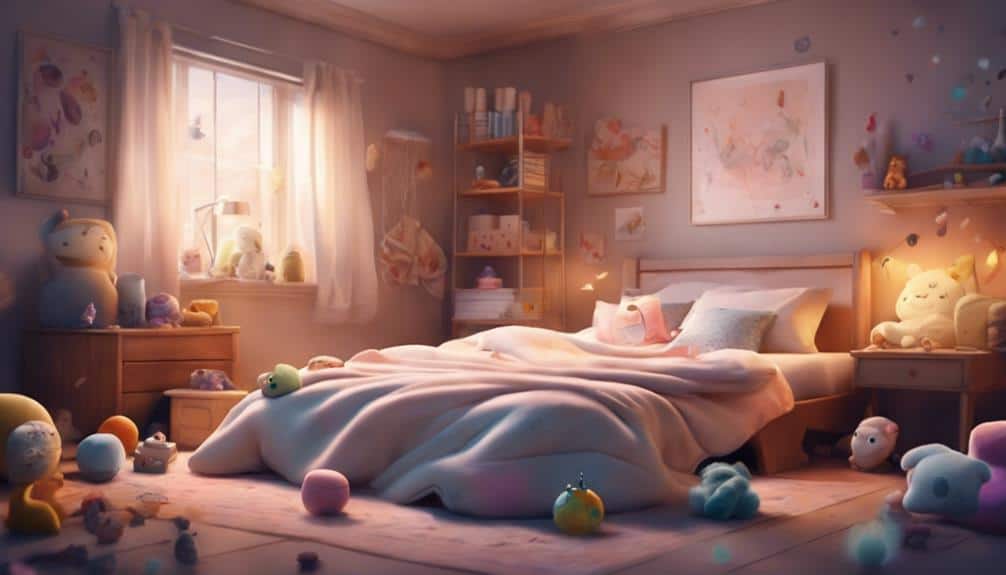
When considering the comfort and support of a bed for an autistic child, the ideal mattress firmness plays an important role in promoting quality sleep.
Sensory-friendly fabric choices can enhance the overall comfort and relaxation for your child.
Additionally, ensuring pressure point relief is essential for preventing discomfort and promoting restful sleep.
Ideal Mattress Firmness
Achieving the right balance between comfort and support is essential when selecting the ideal mattress firmness for an autistic child to promote restful sleep.
- A medium-firm mattress is often recommended for adequate support and comfort.
- Customization may be necessary based on the child's sensory needs and preferences.
- Memory foam mattresses, known for conforming to the body, can offer both comfort and support for better sleep quality.
Consulting with healthcare professionals or occupational therapists can help determine the best mattress firmness for your child's specific requirements. Finding the right balance is vital to make sure your child gets the quality rest they need.
Sensory-Friendly Fabric Choices
To create a soothing and comfortable sleep environment for your autistic child, selecting sensory-friendly fabric choices is pivotal. When choosing fabrics for your child's bed, opt for materials designed to provide comfort and support.
Look for sensory-friendly fabric options that are soft, gentle, and hypoallergenic to enhance the overall sleeping experience. Fabrics with calming properties like weighted blankets or velvety textures can promote relaxation and better sleep quality.
It's important to avoid rough or irritating fabrics that may cause discomfort during sleep. Additionally, consider moisture-wicking and temperature-regulating fabrics to guarantee a cozy and soothing sleep environment for your child.
Pressure Point Relief
For an autistic child, finding a bed that provides effective pressure point relief is essential for ensuring comfort and promoting better sleep quality. Quality mattresses designed for pressure point relief offer ideal support and comfort, reducing tossing and turning during sleep.
Beds catered to pressure point relief are tailored to meet the specific comfort needs of autistic children, ensuring a restful night's sleep. When selecting a bed, consider features that alleviate physical stress, such as memory foam or gel-infused layers that contour to the body's shape.
Investing in a bed with proper pressure point relief can greatly enhance your child's well-being by providing the comfort and support they need for a good night's rest.
- Ideal support and comfort
- Tailored to specific needs
- Alleviates physical stress
Sensory Stimulation

When seeking a special needs bed for an autistic child designed to fit their sensory stimulation needs, consider features like soft textures and gentle vibrations. These beds are crafted to promote relaxation and aid in sensory regulation, ultimately enhancing the quality of sleep.
While sensory beds may not be suitable for every child, they offer a tailored approach to provide a calming environment that suits individual requirements. The sensory stimulation provided by these beds is beneficial for many autistic children, helping them unwind and prepare for restful sleep.
It's important to note that while these beds can be costly and are typically not covered by insurance, the specialized design and focus on sensory needs make them a valuable investment for improving the sleep patterns of children on the autism spectrum.
Size and Space Requirements
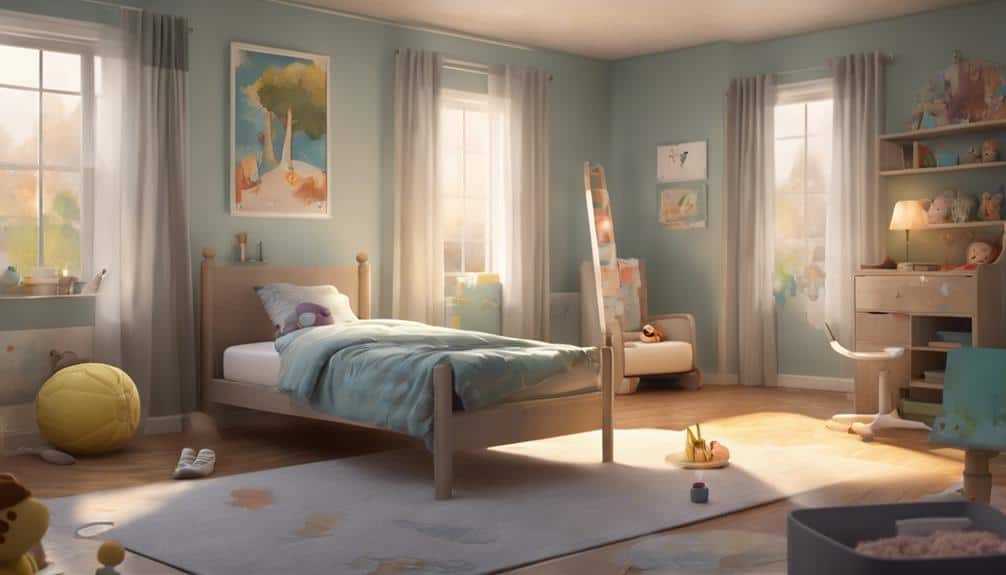
Considering the sensory stimulation needs of an autistic child, the next important aspect to address is ensuring the bed's size and space requirements cater appropriately to the child's comfort and movement during sleep. When selecting a bed for an autistic child, it's essential to take into account the following:
- Bed Size: Choose a bed size that suits the child's dimensions, taking into account their size and weight. A bed that's too small can be restrictive, while one that's too large may not provide the cozy environment needed for quality sleep.
- Comfortable Movement: Guarantee the bed allows for comfortable movement during sleep. This is essential for restless sleepers or children who may need to change positions frequently.
- Fit Well: The bed should fit well in the child's bedroom to optimize space and create a calming environment. Proper size not only ensures ease of movement but also contributes to the overall comfort of the child.
Durability and Maintenance
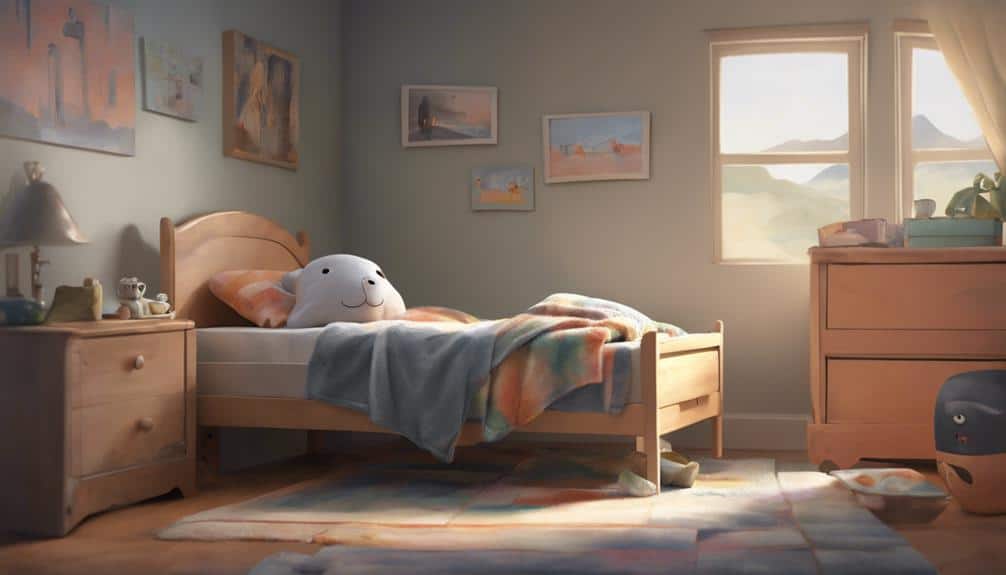
To guarantee the longevity and best condition of the bed for an autistic child, it's essential to regularly inspect for wear and tear and follow the manufacturer's cleaning guidelines. Check the bed frame for any signs of damage such as cracks or weakened joints that may compromise its stability. Loose bolts or screws should be tightened periodically to prevent safety hazards and maintain a secure sleeping environment.
Keeping the bed clean is vital for hygiene and comfort, especially for children with sensory sensitivities. Opt for bedding that's machine washable to facilitate easy cleaning and maintenance. Following the manufacturer's recommendations for cleaning and care will help preserve the quality of the bed over time.
Address any maintenance issues promptly to uphold safety standards and provide a safe and comfortable sleeping space for your child. Prioritizing durability and maintenance will contribute to the overall well-being of your child.
Top Bed Recommendations
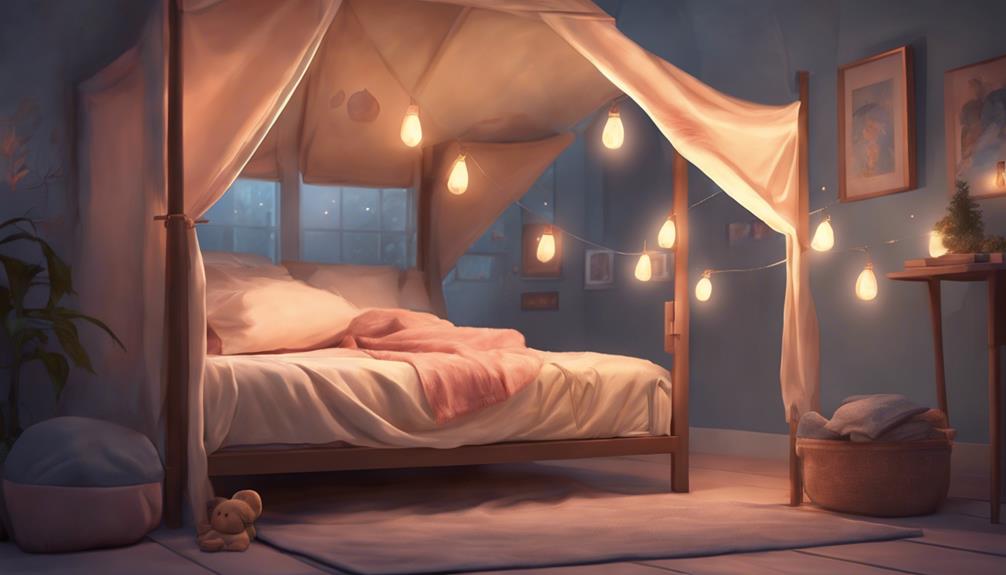
For families seeking the best bed for their autistic child, two highly recommended options are The Safety Sleeper® and Noah's World Bed. These beds are designed to meet the unique needs of children with autism, offering a secure and comfortable sleeping environment.
Here are some key points to take into account:
- The Safety Sleeper®: A secure sleeping solution that prioritizes child safety and comfort, providing peace of mind to parents.
- Noah's World Bed: Combines a safe sleeping environment with a play area, allowing for easy assembly and portability, catering to the needs of children with autism.
These beds aren't only beneficial for children but also for families navigating insurance and Medicaid processes. Assistance is available to help make these essential beds more affordable and accessible. Choosing a bed that meets your child's needs and is covered by insurance can alleviate financial burdens and ensure your child's safety and comfort during sleep.
Frequently Asked Questions
What Kind of Bed Is Best for Autistic Children?
When it comes to creating a safe and comfortable sleep environment for autistic children, incorporating sensory-friendly bedding and a customized setup is vital. It promotes relaxation, sensory regulation, and overall well-being during rest.
What Is the Ideal Bedroom for an Autistic Child?
Creating a sensory-friendly bedroom for an autistic child involves thoughtful decor and effective sleep routine strategies. By incorporating calming elements and establishing a consistent bedtime routine, we can provide a comforting and supportive environment for better sleep quality.
What Is a Safety Bed for Autistic Child?
When looking for a safety bed for an autistic child, it is crucial to take into account features like enclosed sides for security and a comfortable mattress for better sleep. Parents often worry about customization options to meet their child's specific needs.
How Do You Keep an Autistic Child in Their Room at Night?
I use sleep training, sensory tools, and nighttime routines to keep my autistic child in their room at night. Consistent bedtime routines, safety measures like bed rails, and addressing any underlying issues help create a calming sleep environment.
Conclusion
In the search for the best bed for an autistic child, safety, comfort, and durability are key. Like a sturdy vessel sailing turbulent waters, a bed that provides security and support is essential.
By prioritizing these factors and considering sensory needs, you can create a peaceful haven for your child to rest and recharge.
Remember, a bed isn't just a piece of furniture – it's a sanctuary for sleep and well-being.







